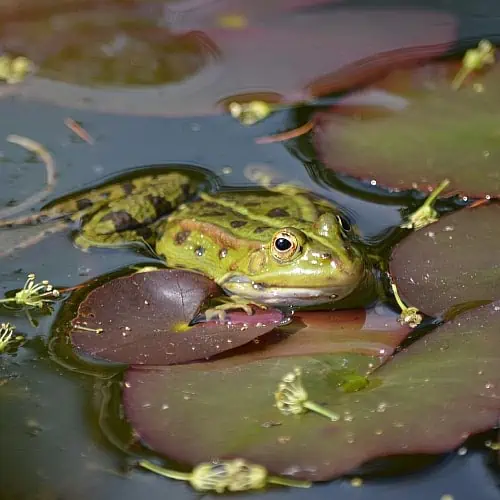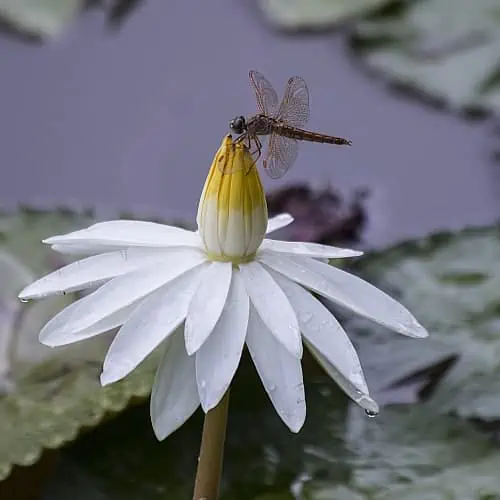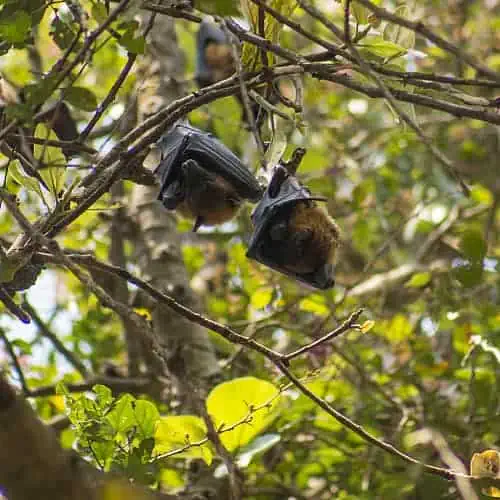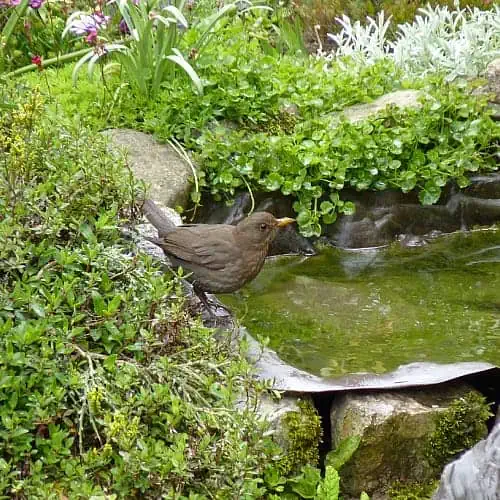
Worldwide, aquatic ecosystems are struggling – approximately 87% of all wetlands, such as bogs and fens, have disappeared (with an exacerbated loss of 98% in the United States), and more than 50% of natural pond and lake habitats have similarly been lost. Within those numbers, 50% have been lost just in the last 40 years. Aquatic ecosystems are among the most unique, biodiverse, and sensitive systems in the world, and with their loss there is a ripple effect felt in virtually every single other ecosystem, including the world of humans.
This means that seemingly simple garden or hobby ponds, no matter how large or small, have a chance to play a critical role in the survival of countless species and provide benefits that extend far beyond your backyard.
Benefit 1) Healthy Ponds Are Indicators of Healthy Environments

Since the vast majority of life on earth relies on water for survival, it should be no surprise that most aquatic systems draw in a large variety of species. With this in mind, by studying a local pond ecosystem, whether manmade or natural, one can surmise how healthy and biodiverse the area as a whole is based on the species that are present within and near that pond.
For example, if you have salamanders, dragonflies, and wild ginger present around your pond, chances are that the area is in decent condition because these are all very sensitive species that require clean water and soils. Amphibians in particular are excellent indicators of ecosystem health – their skin is semi-permeable to allow for gas exchange, meaning that it will also soak up whatever it comes in contact with it. This makes them incredibly susceptible to illness, mutations, and even death if exposed to any pollutants in their water or food, so if these little guys are by your pond, there’s a good chance that it’s healthy! Biologists often collect (and then release) organisms found in water bodies to help determine the health of the water itself and potential positive or negative impacts from the surrounding area.
Contrastingly, if a pond system has other species such as leeches or invasive plants, it’s likely that the surrounding area is degraded and polluted (and thus running off into the pond), as these tend to be species that are found in polluted areas as opposed to clean, healthy ones. In general, the more species of both flora and fauna that are present in and around the water, the healthier it likely is since biodiversity is essential for proper ecosystem functioning.
Benefit 2) Ponds Provide Safe Havens to Native (And Endangered) Wildlife
As mentioned above as well as briefly in previous articles, a large variety of creatures will come to recognize your pond as a secure, healthy sanctuary amidst the ever-changing and developing world. Fresh, clean water, native plant life, and a variety of other factors will aid in the survival of animals ranging from frogs, birds, deer, and countless others.
Amphibians & Reptiles (Salamanders, newts, frogs)

Some may cringe at the thought of scaly and/or slippery little reptiles and amphibians hanging around their pond, but these creatures are actually incredibly important. They are both predators as well as prey, giving them a critical place in the food web in which many other species depend on them. In addition, their sensitivity to pollution and habitat degradation makes them exceptionally useful in monitoring ecosystem health and early detection of potential threats that would affect the rest of the ecosystem – since reptiles and amphibians are among the first to respond to threats, we can monitor their health to see if changes need to be made before the threat is able to impact the rest of the system overly much.
Herps (the term often used that encompasses both reptiles and amphibians, since the study of both of these groups is called herpetology) are also important regulators of insect populations. For example, depending on the species, a single frog can eat as many as 100 insects overnight! With the removal of herps, the entire food web shifts and the ecosystem loses balance – these creatures are often small and in a fairly large abundance where they exist, so their absence means the loss of a very valuable food source for creatures such as birds, and insects will boom since their most avid predators are absent.

Due to their delicate biology, herps as a whole are struggling worldwide as humans constantly alter ecosystems, pollute them, or destroy them altogether. Nearly 25% of all reptile species are endangered and projected to go extinct within the next couple of decades if we don’t take action (that’s almost a quarter of all reptiles!), and this number jumps to 42% (almost half!) for amphibians. Furthermore, there is insufficient data on approximately 25% of amphibian species and 21% of reptiles, meaning that no one really knows if these species are doing well or not. One study conducted by dozens of biologists and ecologists around the world found that as many as 57% of freshwater turtles, 20% of lizard species, and 12% of snakes are threatened with extinction. Your pond can, therefore, truly make far more of a difference than you likely realize in aiding in the survival and health of a myriad of species of these incredibly important and unique animals.
Waterfowl (Ducks, geese, swans, herons)

While you may not necessarily want to attract waterfowl if you have a small pond, these birds provide many ecosystem benefits and are also on the decline as wetlands and ponds disappear around the world. Waterfowl include any species of aquatic bird, such as ducks, geese, grebes, swans, herons, kingfishers, terns, rails, and so on.
This diverse group of birds aids in controlling algal growth as some of them feed on algae, and often help keep waterways open by consuming vegetation that may otherwise crowd everything else out. Still others feed on insects, macro and micro-invertebrates, herps, fish, and thus play a critical role in the food web and keeping aquatic ecosystems healthy. Since most of them are migratory, waterfowl also play a huge part in seed dispersal as they consume vegetation and then fly many hundreds or thousands of miles, thus keeping plant communities diverse and thriving. This can, of course, backfire when invasive plant species are involved – so make sure to only plant native species and eradicate any invasives!

Your pond can provide a much-needed stopover point during migrations. Waterfowl often need a place to rest from time to time while migrating, but the diminishing amount of freshwater sources can make this difficult and cause some to die of exhaustion, dehydration, or lack of food.
Typically, aquatic birds only stop for a day or two to regain some energy, unless you are where their migration typically ends. In this case, typically only larger ponds will be inhabited, and if you don’t wish to have many of them around there are some steps you can take to protect your pond from potential damage.
Passerines (Song birds & roosting birds)

Passerines are any species of roosting or perching bird, and includes over 50% of bird species, such as bluebirds, jays, sparrows, warblers, hummingbirds and sunbirds, and so on. As the largest group of birds, they are also the most diverse and therefore perform the greatest variety of ecological functions. These birds may not choose to live by your pond, but are very likely to stop by to at least grab a drink, rinse off, cool off, seek shelter, or feast on some of the things that do call your pond home, such as insects, herps, seeds from plants, and nectar from flowers, among other things.
About one in eight bird species are threatened or endangered, according to the IUCN Red List. This is a problem, as birds are exceptionally important for seed dispersal and germination, and can also aid in plant pollination and insect control. Even in locations with a diverse range of habitats, those containing a water source have been found to be more preferred by birds in general than any other habitat type. In addition, ponds and other water habitats contain many times as much diversity and bird species than habitats that don’t contain water. Furthermore, many bird species, such as the critically endangered black-winged kite, will only breed in areas with water, making pond ecosystems exceptionally important for the continued reproduction and therefore survival of countless bird species, passerine and waterfowl alike.
Mammals (Deer, foxes, hedgehogs, opossums)

It should come as no surprise that mammals will also stop by your pond to drink and possibly get some grub, whether that be from grasses and other vegetation or eating things like insects, herps, or birds. Mammals aren’t struggling globally quite as much as other animal groups, but locally they may face many challenges. For example, habitat fragmentation makes it difficult for mammals to obtain the resources that they need, such as shelter, food, and water. They may have to cross busy roads or wander through urban areas in order to find what they need, which puts them at great risk of death.
Your pond, whether it’s a small garden pond or a large farm pond, can provide them with valuable water and potential food and shelter while they pass through. In fact, creating “habitat patches” in degraded areas that help connect larger tracts of habitat is a wildlife management strategy that is used by biologists to help reduce wildlife deaths as they move about trying to find food, water, mates, and so on in our increasingly developed world. With this in mind, your pond can provide a much-needed patch of habitat for them to stop at on their journey, so don’t be surprised if you see deer, foxes, or even larger critters like cougars and bears passing through.

In addition, depending on your location you may have bats visit your pond nightly! As the world’s only flying mammals, bats are incredibly unique and important. In fact, studies have found that agricultural areas that have healthy bat populations also have greater crop yields, as the bats consume hundreds of thousands of insect pests per night that would otherwise feast on the crops. This same function would be performed at your pond (except on a bit of a smaller scale). In the U.S., over half of the bat species are either extinct or in danger of becoming so. This is due to habitat loss as well as human-driven climate change that enables diseases such as white-nose syndrome to decimate populations and spread quickly across entire continents.
If you’re lucky, you’ll also get some opossums visiting your pond! While they get a bad rep and are often vilified due to their appearance and tendency to hiss when threatened, possums are considered a keystone species in some areas. They’re immune to rabies, and love ticks – a single possum can eat as many as 400 ticks in just one day. This greatly cuts down on the transfer of tick-borne diseases and infections to both animals and people. They provide a variety of other ecological functions as well, including eating rats and mice that can carry disease and would otherwise become overly abundant since they breed so quickly.
Benefit 3) Ponds Help Cycle Nutrients & Remove Environmental Pollutants

This isn’t true for all ponds – it of course depends on abiotic factors such as location, precipitation, and so on – but in general, water ecosystems help to cycle nutrients. Often times, nutrients (and anything else, such as pollutants) end up running off into the water depending on elevation, or will enter the water via precipitation since many things are able to evaporate into the atmosphere and then fall elsewhere as rain or snow. Natural, healthy aquatic systems are able to handle this to an extent, and cycle the water via water movement and plant life.
Plants are able to soak up excess nutrients so they don’t overload the system, and some are quite adept at filtering pollutants as well. The more plants that you have both in (emergent plants work best within the pond) and near your pond (tall grasses with deep root systems and trees work best on land), the more efficient it will be at cleaning and protecting itself.
How Can Pond & Garden Owners Help?
So, now that you know how very important ponds are, what can you do to make sure that yours is as healthy as possible and thus aids in protecting and conserving the natural world? Well, quite a number of things!
1) Incorporate Plenty of Native Plants

Plants, particularly emergent vegetation, will provide plenty of shelter, foraging opportunities, and shade that will draw in herps and birds while also enhancing the habitat for your fish and improving overall water quality. In turn, this will bring in mammals like those mentioned above and help create a fully functioning ecosystem that isn’t overrun by any one species. As mentioned above, plants will also aid in nutrient cycling and filtering out pollutants that would otherwise harm the water quality, your fish, and anything else that chooses to visit. Make sure to only incorporate plants that are native to your region, as non-natives can wreak havoc on surrounding ecosystems as they are able to easily spread and outcompete native plants that haven’t evolved to know how to handle the newcomers.
On the topic of invasive plant species, if you have any on your property it’s exceptionally important that you eradicate them as quickly as possible. A variety of methods are available to do this, ranging from utilizing herbicides, burning, cutting, and manual removal of the entire root system. To find out which plants are considered invasive, noxious, or environmentally threatening in your area, the National Invasive Species Information Center is an excellent resource. You’ll also need to contact your local authority, whether that be the Fish and Wildlife Service, the Forest Service, or an organization that does invasive species removal. You may need to obtain a permit in order to conduct burning or to apply herbicide, or hire a professional to do it for you. In some cases, it may get done for free if that species is a particularly well-known threat.
2) Create Microhabitats

This tip was covered in another article and is a fairly straightforward method to use. Microhabitats are all of the smaller habitats that are found within an ecosystem. For example, having a deeper, pool-like portion of your pond, a shallow area, an area with more water movement, and an area with more vegetation could be considered four micro-habitats, all just within your pond. These would provide plenty of habitat to suit all manner of fish, herps, and micro/macro-invertebrates.
Outside of your pond, you could try having one side that is open and grassy, another that is wooded, faces a forest or at least has some trees and shrubs, and another that has flowers to attract pollinators and insects. Not only will this diversity bring in a greater variety of wildlife, but it will also improve the overall area by providing multiple functions. The forest/trees as well as grasses (if they have deep root systems, like bluestem grasses) will help to sequester carbon (and therefore aid in a cleaner atmosphere!), the water and any emergent vegetation will help filter nutrients and pollutants, and flowers will attract valuable pollinators and other birds and insects.
The carbon that is sequestered by the plant roots will release compounds known as rhizodeposits, which greatly improve soil quality and health by allowing helpful bacteria and enzymes to establish and grow in the soil and making micronutrients like zinc and macronutrients like phosphorous more readily available to the plants themselves, and thus to the rest of the ecosystem.
3) Limit Chemical Use

While chemicals can be necessary in some cases (such as helping to control invasive species), remember that anything designed to kill something is very likely to harm other things as well. Try to use natural means as much as possible, such as including more plants and aeration equipment to keep your pond clean, and if you do use chemicals, keep it to a minimum and adhere strictly to the usage instructions. Some chemicals can kill plants, fish, and a variety of other organisms, so you’ll need to really do your research on which chemicals are safe to use, in what quantity, and how often for your particular needs. Keep in mind that the more natural you keep your pond and truly work to create an ecosystem, the less likely it is that you’ll need chemicals because a diverse, natural system is better equipped to take care of itself.
4) Provide Slopes and Substrate

Make sure that at least one side of your pond has a gradual, shallow slope to allow easier access for wildlife. Insects such as damselflies will land on this shallow portion to rest, drink, and feed on small microorganisms, algae, and other insects. Waterfowl will use it as a sort of landing strip to easily enter and exit water, while smaller passerine birds will use it for bathing, drinking, and searching for food in the shallow water.
Frogs, turtles, and other reptiles and amphibians will have a much easier time entering and exiting your pond via the slope, especially if you add in a few rocks and/or floating plants, and some of your fish are likely to enjoy the shallow water as well. Mammals will be able to easily take a quick drink from this area without risk of falling into deep water. To prevent predation on your fish, at the end of the slope you can incorporate a shelf or quick drop off so that your fish can swiftly escape the shallow area to the security of deeper water when potential threats are present, without said threats being able to follow particularly easily. For example, raccoons are opportunists and may try to snatch some fish in shallow areas, but they’re very unlikely to venture into deeper water as they’re fairly lazy creatures, nor do they enjoy diving underwater.
In addition, having an actual substrate bottom for you pond (rather than just a liner) will aid in a variety of ecosystem processes. For example, the sediment will be able to hold carbon and other nutrients, host beneficial microorganisms and bacteria that aid in overall water quality, provide food (via said microorganisms as well as invertebrates) for your fish and other pond dwellers, and also will allow plants to more easily grow (while also being healthier due to obtaining nutrients from the sediment). The sediment will also help to filter the water. However, every few years you may need to scoop out an inch of two or sediment to prevent it from building up too much as organic waste from animals and plants settle to the bottom and break down over time.
5) Be Conscious of the Fish Species in Your Pond

If you have a farm pond or naturally occurring pond, it’s likely that your pond will have fish species typical of the overall area. If you have a garden pond, however, it’s likely that you’ll have domesticated varieties such as koi, orfe, goldfish, plecos, and so on. Oftentimes, this is just fine so long as you do not release them into natural rivers or ponds. However, some fish species are able to escape and can really damage surrounding natural waterways that they get into.
For example, golden orfes, hatchetfish, and African butterfly fish are all adept jumpers and have been known to escape ponds. When this happens, they either die if they land on dry ground or, if another water source is nearby, they enter that water and then become an invasive species that outcompetes native fish and causes a great deal of damage over time as they breed and spread. To combat this, if you wish to have these species in your pond you must have a fairly large pond of several thousand gallons and several feet deep to minimize the chances of them being able to (or wanting to) jump out.
6) Avoid Using Fertilizers

Fertilizers are wonderful for stimulating plant growth, but when used near water sources they can also do more harm than good. Any nutrients that don’t get soaked up by plants will run off into the water, and this in turn over-nutrifies the water and can cause eutrophication, algae blooms, and fish kills.
If you wish to use fertilizer, a simple way to prevent causing issues is to purchase a test kit. You would simply place the probe in your soil, and it will tell you which nutrients are present and in what quantity. This way, you can buy fertilizers that contain only the nutrients that the soil has a deficiency of and thus avoid adding excess ones that it doesn’t need that will just runoff into the water.


This page was very informative and provided exactly what I needed without being abstruse. A lot can be learnt about the environment which is very beneficial to students pursuing environmental-based degrees.
Hi Jo,
Very happy to hear that! Thank you for reading and for your kind words.
Thanks loads, it helped me a lot understanding the ecosystem of pond as i am writing a report on a pond in india.
Hi Shinjini,
Thanks for reading! We’re glad that the article was helpful to you.
we are also working in pond safety report can you please help us
Thanks for providing such an in-depth information about ponds . We are trying to save water and focus is to save what we have and store when it rains. We also want to spread awareness about revival of the ponds .
Somehow the response is not favorable , still we are hopeful.
Regards
Hi A D,
Thanks so much for reading and commenting, and for caring about our natural resources! I’m sorry that responses to your efforts haven’t been favorable; rest assured, there are many others who also care, and in time I’m confident that your efforts to spread awareness will yield some positive results. Change, particularly changes in perceptions and attitudes, take time. Keep fighting the good fight 🙂
We installed our TN koi pond 13 years ago and at that time it was all about the fish. I had no idea just how important it would become to the local habitat that call it home or visit during migration and the thriving eco system it has created. I just joined twitter May 2023 William C @musiccitypark something that I said I would never do, but only because I wanted to start sharing photo’s of all the amazing wildlife that are here. The trees and plants surrounding it have matured and the eco system is strong as it has ever been and flourishing. Everyday something is running around the pond or stops by to get a drink or bathe in the waterfall and bird bath. While the pond is beautiful I believe the sound of the waterfall is what draws the wildlife to it 90% of the time and to the bird bath. I do see birds gather algae from the waterfall for building their nest and the bull frog has also made it his home. I have enjoyed this pond every single day especially since the wildlife moved in. Even when I’m inside the house there is always something running around or flying by which catches my eye and I just can’t seem to stop looking outside. I’ve seen everything from baby turtles being born here to saving a baby rabbit that got spooked by our dog and jumped into the pond to get away. I’ve lived in this area all my life and i’m seeing birds that I have never ever seen before and they are returning year after year with their young. Throughout the day every view changes due to the shadows from the trees. I have found my happy place and I if I’m not outside I’m usually looking that direction.
thank you Becki great info.